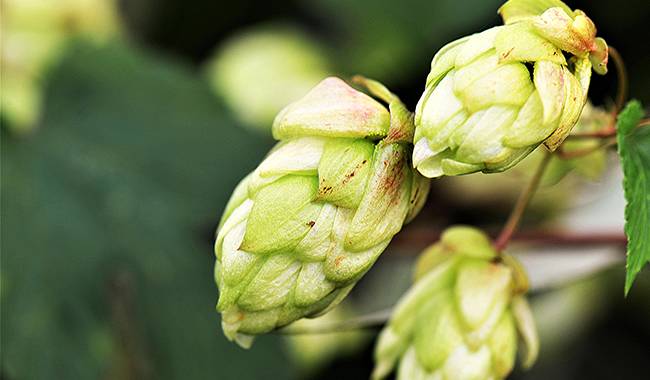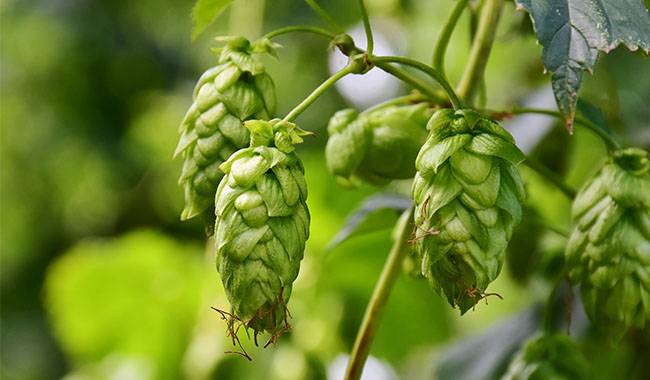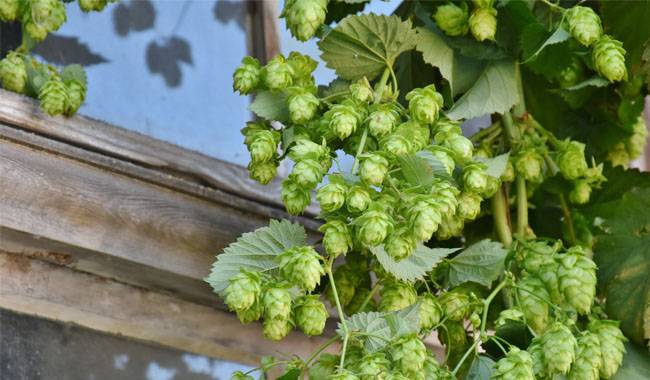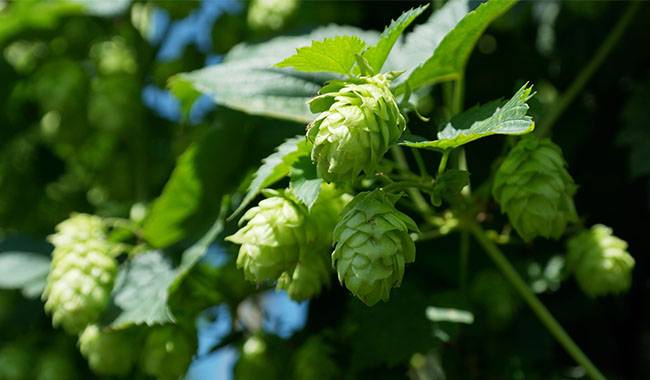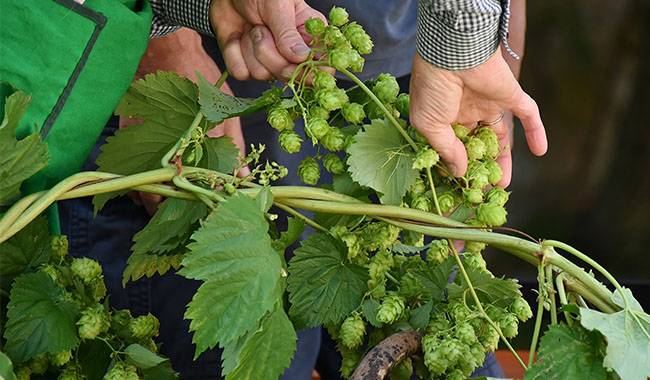
How to grow hops in your backyard? The female flowers of hops vine rotting grass provide beer with its characteristic bitterness, flavor, and aroma.
Brewers have also taken advantage of their natural preservative qualities for years. If you choose to grow hops at home, they can also bring great satisfaction and bring you closer to a truly unique craft beer.
Hops are a durable perennial that can be easily grown at home with enough sunlight and climbing space.
Hops produce annual vines from permanent rhizomes called crowns. The vines can grow 25 feet (7.62m) tall in a single season but die to the crown each fall.
The crown also produces underground stems or rhizomes. The root-like rhizomes sprout many shoots, which are essential for reproduction.
BASIC REQUIREMENTS
Sufficient space
Since healthy hops plants can grow up to 1 foot a day, it is important to consider the space factor before planting a hops farm.
Site Selection
The ideal hop yard must have direct sunlight, easy access to water, and sufficient vertical growing space. A fence, garage, or space on the property boundary has the potential to be used as a hop yard.
Hops vines also need a strong support system to grow successfully. Tall poles and sturdy twine are often used to support the vines. Growers should avoid potential problems caused by spreading spread and avoid sites with power lines nearby.
Soil
The soil must be fertile and well-drained with a pH of 6.5-8.0. Since hops consume a lot of water and nutrients, the soil needs a fertilizer rich in potassium, phosphate, and nitrogen. Home growers can use compost and commercial fertilizers for this purpose.
Climate
Hops vines need at least 120 frost-free days to bloom, regardless of where they are grown. When the stems break the ground, you must support the vines in the ground to prevent disease and ensure proper growth.
Vines grow until mid-July, when most hops are either in full bloom or in full flower, depending on the variety and location. Healthy vines can produce 1-21 / 2 pounds of dried flowers per plant.
Seeding
Once a location has been identified and the soil fertilized, seeding can begin. At northern latitudes, snakeweed can be affected by freezing temperatures.
To avoid rhizome rot, plant after the threat of frost has passed. When temperatures rise to the point where most spring flowers begin to appear, the vines will destroy the soil.
The actual start of growth will vary depending on local spring temperatures. Growers do not have to worry about whether vines in Central California will break earlier than those in Montana: emergence rates vary with the climate.
Planting begins at the rootstock
If you postpone the preparation of the seeds, the rootstocks must be refrigerated in plastic bags to prevent drying out. Ideally, you should plant rootstocks in early spring, but no later than May.
Late sowing limits the plant’s growth potential. In cooler climates, you can start rhizomes in pots and move them into the ground by June.
When ready, plant rhizomes vertically so that the shoots point upward or horizontally about 2 inches (5.08cm) below the soil surface. Space the rhizomes differently from each other.
You can plant a mix of varieties but at least 5 feet (152.4cm) apart; the same varieties can be planted 3 feet (91.44cm) apart.
Care and feeding
Like any young plant, too much water can cause more harm than good. During the first year, young snake hemp has the least amount of roots and requires frequent watering.
Mulching the soil surface with organic matter is a good way to retain moisture and help control weeds. After the first season is over and the plants are established, infrequent deep water irrigation (such as drip irrigation) works well.
In the first year, don’t expect much growth or flowering as the plant is establishing its root system. Instead, look forward to the second year, when the hops are fully grown and producing healthy fragrant flowers.
When the hops vines are about 1 foot long, select two or three sturdy vines and wrap them clockwise around a support system. The support system can be a lattice frame, tall poles, or thick twine.
Hops grow primarily in the vertical direction, but the lateral arms extend from the main spreading vine. The main concern is to support the vines and prevent the side arms from tangling. Tangled vines become a particularly important issue when growing mixed varieties in the same yard.
In newly planted hops yards, emergent growth is cause for celebration. Growers tend to let every bud grow and climb.
While this is understandable, keep only selected buds and prune the weaker ones at ground level.
This can be painful for the first-time gardener, but it forces the strength of the roots into the harder buds. Selected buds will automatically take care of themselves after training or packing.
The early development of a hops field is amazing. If you are not concentrating, then it will definitely develop into a patch of vines. Strict pruning, just like pruning two to three buds per vine, is a basic task that must be done every few weeks.
If you struggle with a tangled vine, neglected pruning can make harvesting difficult.
WHEN TO HARVEST HOPS
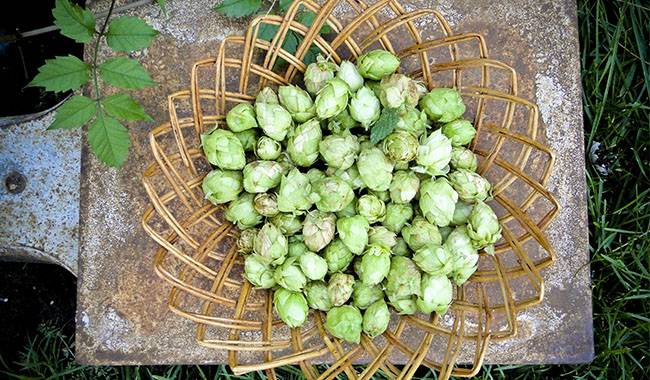
Hops are ready to be harvested when the leaflets (leaves) of the hop cones begin to turn papery and the edges turn brown.
When the hop cones are broken open, the hop hormone glands should be yellow and sticky. The general guidelines for picking are as follows.
Pick a third of the hops when only a few of the bracteoles have just turned brown. Then, go back a few days later and do the same. Don’t wait until the hops turn brown before picking.
Use the color of the hop tips as a guide. Make sure the hops are ripe before picking a large number of hops.
Check the brown leaf tips, lupine glands, and even taste the hops yourself to make sure your hops taste good.
If you harvest too early, your hops will not have the potency you expect and may impart a chlorophyll taste to your beer.
IT’S A PICK-YOUR-OWN PARTY
All summer long you’ve been planning, pruning, monitoring, and caring for your hops, and now those little cones have arrived! Be patient. Be patient. A common mistake is picking hops too early. You want to pick overripe hops, not underripe hops.
Depending on where you are, mid-August through September is the harvest time for hops, and aromatic hops are the first to ripen. As the resin and oil develop, the cones send water and nutrients from the bracts into the lupine glands, leaving the cones slightly darker and papery. Look for the tips on the cones to become a little dry before picking, and wear a long-sleeved shirt。
There are several ways to check the ripeness of the hops.
Gently squeeze the fruit occasionally, when it feels light and dry, and springs back after squeezing.
Pick up fruit, roll it in your hand and smell it. If it has a pungent odor somewhere between cut grass and onion, it’s ready to harvest.
Roll the hops next to your ear. If it makes a cricket sound, this also means they are ready to harvest. If the lupine turns orange and smells rotten, you’re past harvest time.
For the first year of lupine, try to pick the cones and not cut the lupine until it wilts. This will lend the necessary nutrients to the roots over the winter.
For the following years, cut the vines down and be careful not to damage or soil those precious kale glands.
You should expect one to two pounds of dried hops per mature plant. Now invite some friends to help you pick hops while enjoying some home-brewed beer!
DRYING
Freshly picked hops can go directly into the kettle for fresh hop brewing, or they can go into the drying process. When drying hops, you have to keep three factors in mind: time, heat, and moisture.
To prevent oxidation and isomerization, the drying time should not exceed three days. You can speed up drying by putting them in the oven and checking them every 20 minutes to watch closely. The heat you use should never exceed 140°F (60°C).
You can also use a drying net to dry your hops. Place landscape fabrics on top to keep them in the dark and occasionally fluff the hops so that the moist inner cones are brought to the outside of the pile. Use a fan to speed up the process.
Hops need to have a moisture content of 8% to 10% (by weight) to prevent molding. A quick way to see if the hops are dry enough is if the center stem is almost brittle enough to snap in half. Once the hops are dry, vacuum seals a bag and store it properly in the refrigerator.
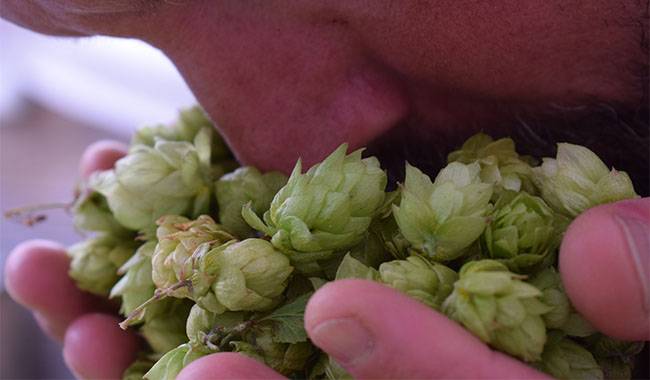
CAN I GROW RHIZOMES INDOORS?
No, hops should not be grown indoors. Their rhizomes require too much space to stretch and the containers are not large enough to support their growth.
These plants are not small when they grow. Many people are unfamiliar with what hops look like in the field, but most people know what a grapevine looks like.
Hops grow in the same way that grapevines grow. They get big, take up space, and require a lot of height.
Trying to “start” your hops indoors is also not a good idea. Several states are still dealing with winter issues due to the timing of the hops we receive.
You don’t want to grow hops on frozen ground. Some of you might ask if we can start planting indoors when the ground is warm enough?
Again, no, this is not feasible. Just keep the rhizomes in the freezer until you can plant them outdoors. Spray the rhizome with water every few days so that it stays alive.
Remember, rhizomes don’t need much water, so just spray enough. Hop rhizomes can be stored in the refrigerator for months without a problem.
We have planted the oldest, smallest, nastiest looking rhizomes you can imagine. To our surprise, our staff is also excited that they have grown.




